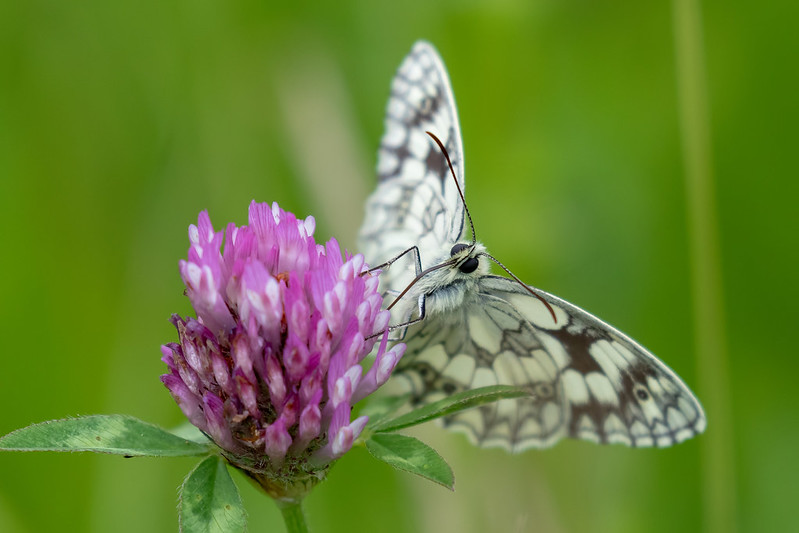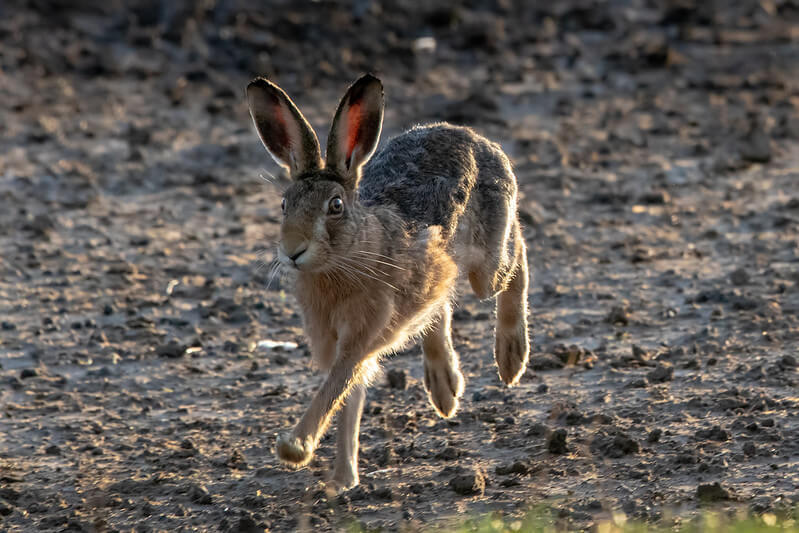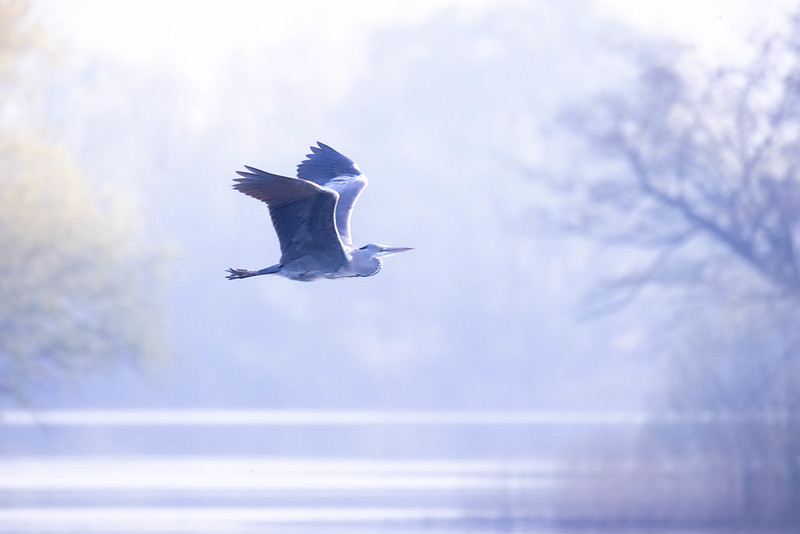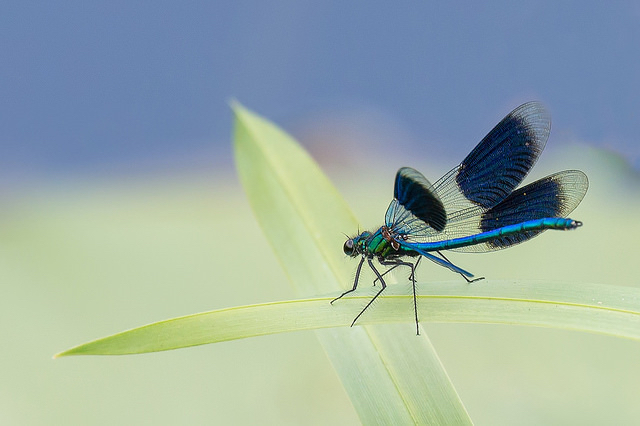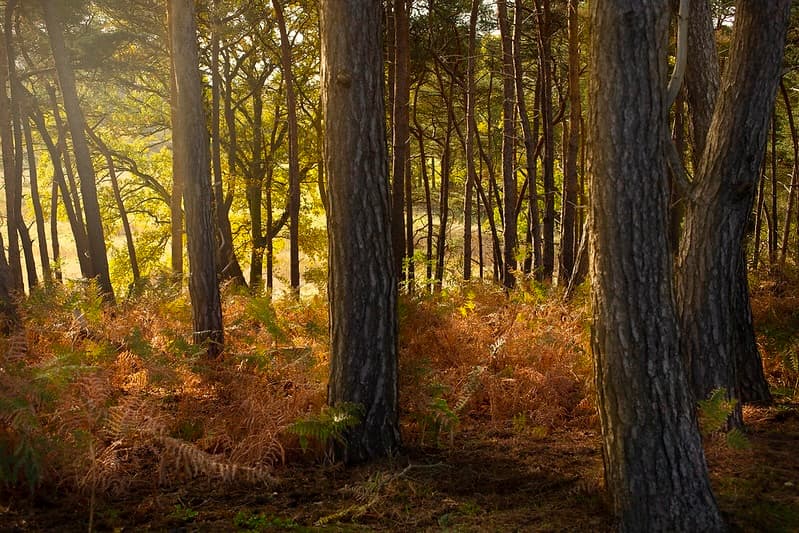- Home
- Getting into wildlife photography
Getting Into Wildlife Photography: A Beginner's Guide
Ever wondered how a single photo could change things?
For me, it started with a blurry shot of a raptor, soaring over the Corby countryside.
Not what I expected to see heading home from the supermarket. But as I zoomed in its talons and piercing eyes, something clicked...
Not just the shutter, but something in me.
I didn’t just want to take pictures of wild creatures...
I wanted to tell their stories.
That one moment led to early mornings, waiting for perfect light, and learning (the hard way!) that wildlife doesn’t follow schedules.
Spring came, and I found myself searching for one particular iconic insect...
Then suddenly—I realised I was already looking right at it.
Moments later, I had a miracle: a sharp, well-exposed shot of a May fly, wings glinting in the light, safely captured on my SD card.
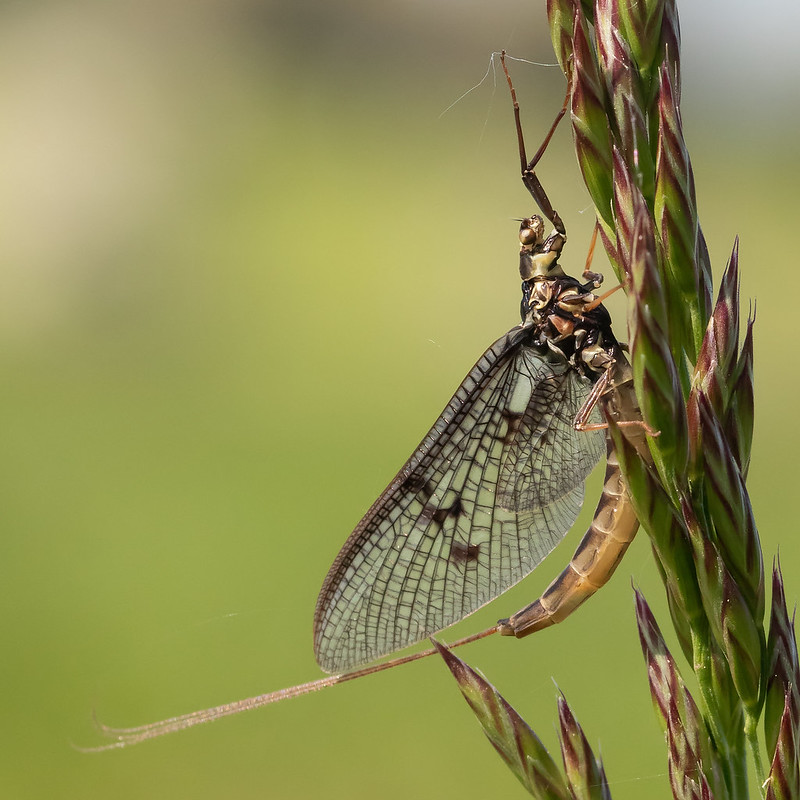 May fly, f/9, 1/1600th second, ISO 1600 with my 100mm macro lens.
May fly, f/9, 1/1600th second, ISO 1600 with my 100mm macro lens.But it wasn’t until I entered it into a local newspaper’s wildlife photo competition that I realised the true power of an image.
The photo won—and with it, introduced this small, often-overlooked insect to so many new admirers.
Suddenly, my hobby wasn’t just about capturing pretty pictures.
It was about making a difference.
Now, whenever I pick up my camera, I’m not just chasing the perfect shot.
I’m searching for ways to connect people with the natural world, to help them pause, look closer, and feel something.
So, what’s the next story waiting to be told?
Maybe it’s yours.
All you need is a camera, a bit of patience, and the willingness to see the world through a different lens.
Who knows? Your photo might just be the one that changes everything...
Let’s look at what you’ll need to get started without overcomplicating things.
Choosing The Right Gear
Getting started with wildlife photography doesn’t mean you need the most expensive gear.
In fact, the may fly photo above—one of my first big wins—was taken with my old Canon 7D Mark II.
What matters most is finding equipment that fits your needs and your budget. Something that helps you capture the kind of moments that speak to you.
Here’s what to look for when choosing a camera:
Camera Basics: What to Look For
Your camera doesn’t have to be fancy, but it should be able to keep up with nature.
Wildlife can be fast, unpredictable, or low-lit, so these four features really help:
- Fast, reliable autofocus Wildlife moves quickly. A good autofocus system helps you keep your subject sharp, even as it flits or bolts across the frame.
- Burst mode & a good buffer Burst mode lets you take a series of photos in quick succession—perfect for catching takeoffs, splashes, and action moments. A camera with a big buffer won’t freeze mid-shot.
- Strong low-light performance (High ISO) Wildlife often shows up at dawn or dusk. You’ll want a camera that handles higher ISO settings without too much grain.
- Weather resistance Nature rarely cooperates with the forecast! A weather-sealed body protects your camera from mist, light rain, and dusty trails so you can keep shooting with confidence.
💡 Don't worry if your camera doesn’t tick every box—these are things to aim for over time, not all at once.
 This kestrel was perched in the tree. I set the camera to burst mode and caught it taking flight. f/10, 1/2000th sec on 100-500mm lens.
This kestrel was perched in the tree. I set the camera to burst mode and caught it taking flight. f/10, 1/2000th sec on 100-500mm lens.🛠️ Learn from my experiences
Wildlife photography in the rain. - I share three stories of being caught by the elements
Taking wildlife photos in low light. The challenges of a wildlife photographer (me)
Budget-Friendly Camera Bodies
Not sure where to start with your first camera? These beginner-friendly options balance image quality, speed, and ease of use—without blowing your budget.
| Camera | Why It’s a Good Fit for Beginners |
|---|---|
| Canon EOS R50 | Compact, lightweight mirrorless body with excellent autofocus and intuitive controls—great for new wildlife photographers. |
| Nikon Z50 | Excellent low-light performance and responsive handling. A solid entry into Nikon’s mirrorless lineup. |
| Sony a6100 | Super fast autofocus tracking, especially for moving subjects. Compact and beginner-friendly with great image quality. |
Lens Options: Finding the Perfect Match
Your lens choice plays a huge role in how close you can get, what details you can capture, and how your final photo feels.
Here are the three main types of lenses I use most in wildlife photography—each with its own specialty:
🐦 Super-Telephoto (150–600mm)
These lenses are perfect for photographing birds, deer, or anything you need to admire from afar.
They help you stay at a respectful distance while still capturing beautiful detail.
Yes, they can be heavy—but they open up a whole new world of wildlife moments you’d otherwise miss.
🐛 Macro (90–105mm)
I love macro lenses for insects, flowers, and tiny wildlife.
If you’ve ever crouched down to watch a bee or damselfly, a macro lens helps you bring those small moments to life.
🌄 Wide-Angle (16–35mm)
Use this when you want to show an animal in its environment - like a swan gliding through a foggy lake, or a fox walking along a hedgerow.
These lenses are also fantastic for landscapes or capturing the light and setting around your subject.
💡 Tip: Don’t feel pressured to own every type of lens. Start with one that suits your current interest—and grow from there.
Recommended Focal Lengths for Different Subjects
If you're not sure which lens to reach for, here's a quick guide I use all the time:
| Subject | Suggested Focal Length |
|---|---|
| Birds in flight | 400–600mm |
| Large mammals | 200–400mm |
| Insects & small wildlife | 90–105mm macro |
Budget-Friendly Lens Options
You don’t need to spend a fortune to get started. These are some reliable, beginner-friendly lenses I’ve used or tested personally:
| Lens | Why I Recommend It |
|---|---|
| Sigma 150–600mm f/5–6.3 Contemporary | A flexible super-telephoto zoom—great reach for birds and distant wildlife without breaking the bank. |
| Tamron 100–400mm f/4.5–6.3 | Lightweight and more affordable than most long lenses. Ideal for handheld wildlife photography. |
| Canon RF 100mm f/2.8 Macro | My go-to macro lens for insects, flowers, and close-up textures. Beautiful detail and crisp images. |
Accessories for Wildlife Photography
The right accessories can make all the difference in your wildlife photography, helping you capture sharper images and protect your gear in the field.
Here’s a breakdown of essential tools to consider:
Steady Shots: Tripods, Monopods & Beanbags
A sharp wildlife photo often comes down to one thing: stability.
Here’s how to choose the right tool based on how and where you like to shoot:
Tripods:
Best for when you're staying in one spot—like a hide or quiet corner of a reserve.
- Ultra steady for longer lenses
- Great in low light with slower shutter speeds
- Reduces arm fatigue during long sessions
Tip: Look for one with quick-release locks for easier setup in the field.
Monopods:
Ideal for hikes or when you're constantly on the move.
- Adds support without full bulk
- Quick to reposition for fast-moving subjects
- Can even double as a walking stick on rough ground
Beanbags:
Surprisingly versatile and great for low-angle shots or shooting from a car.
- Perfect for ground-level mammals or birds
- Very light and packable
- Steady when rested on a rock, log, or vehicle window
Tip: Don’t overlook comfort. Wildlife photography often means sitting still for a while—bring a mat, stool, or lightweight seat if you can!
🛠️ What to know more?
Low angle photography. - See the difference it makes to my photos
Memory Cards: Don’t Run Out of Space
When you’re out in the field, the last thing you want is to run out of storage—or miss a shot because your camera is still saving the last one.
Here’s what to look for:
-
Capacity:
At least 64GB (or higher) so you don’t need to stop and swap mid-shoot—especially if you’re using burst mode or shooting video. -
Speed:
Fast write speeds (UHS-I or UHS-II) help prevent your camera’s buffer from filling up too fast during continuous shooting.
💡 Bring a spare! Even seasoned photographers forget to clear their card before heading out.
Protective Gear: Keeping Your Equipment Safe
Wildlife photography means heading outdoors—in rain, wind, mud, or sun. The right protection keeps your equipment working longer (and keeps you relaxed when weather hits).
Camera Bag
- Choose one with padded dividers and weather-resistant fabric
- A good fit prevents your gear from bouncing or rubbing as you walk
- Backpack-style is ideal if you're walking long distances
Rain Cover
- Compact and affordable
- Keeps your camera dry during unexpected showers
- Even a basic sleeve helps protect buttons and dials
Lens Hood
- Helps block glare or stray light
- Adds a layer of protection against bumps and scratches
- leave mine on 90% of the time—just in case!
Field Tip: I keep a microfibre cloth and a couple of silica gel packets in my bag. Condensation and moisture happen—especially when going from cold outdoors to a warm car or hide.
Understanding Your Camera Settings
Wildlife photography often means adjusting your settings on the fly—especially when light, weather, or your subject suddenly changes.
Let’s break down the three core settings you’ll use most: aperture, shutter speed, and ISO.
Aperture (f/number)
The aperture controls how much light enters the camera through the lens. It also affects how much of the photo is in focus (your depth of field).
Wide aperture (low number like f/2.8–f/5.6)
- More light enters
- Creates a blurry background that makes your subject pop
- Ideal for wildlife portraits or isolating a bird from the bushes
Narrow aperture (high number like f/11–f/16)
- Less light enters
- More of the scene stays sharp, which is great for herds, landscapes, or birds in flight
Shutter Speed
Shutter speed controls how long your camera’s shutter stays open—and how motion is captured.
Fast shutter (e.g., 1/2000s)
- Freezes action (like a bird flapping or a deer running)
Slow shutter (e.g., 1/30s)
- Allows motion blur, which can be artistic (like mist over water), but needs a tripod to stay sharp
For birds in flight, I use at least 1/2000s. For more still subjects, you can go slower if you're stable.
ISO (Camera Sensitivity to Light)
ISO adjusts how sensitive your camera is to light.
Low ISO (100–400)
- Best for bright conditions
- Produces the cleanest, sharpest images
Higher ISO (800–3200)
- Useful in low-light moments (dawn/dusk), but may introduce some grain (or "noise")
Modern cameras handle higher ISOs better than older ones. I’ve shot usable photos at ISO 1600 and beyond when the light was low but magical.
Quick Reminder:
- Aperture = controls background blur and light
- Shutter speed = freezes or blurs movement
- ISO = boosts brightness, but too high can reduce image quality
It’s all about balance—and a little practice goes a long way.
🛠️ What to know more?
How to change camera settings. - My settings for different wildlife scenarios
Making a dark photo brighter. - Check out my case studies
Aperture and Depth of Field
Aperture doesn’t just control how much light gets in—it also changes how much of your photo is in focus.
This is called depth of field (DoF), and it’s one of the most powerful creative tools in wildlife photography.
For portraits of wildlife, use a wide aperture (e.g., f/4 or f/5.6) to blur the background and make your subject stand out.
To capture more detail in a scene, choose a narrower aperture (e.g., f/11 or f/16) to keep everything in focus.
 xample: A flock of Common Cranes at Welches Dam, captured at f/8 with enough depth to show the entire group.
xample: A flock of Common Cranes at Welches Dam, captured at f/8 with enough depth to show the entire group.💡 Tip: The longer your lens, the shallower the depth of field—even at the same aperture. A 400mm lens at f/5.6 will blur more than a 100mm lens at the same setting.
Shutter Speed for Freezing Action
Wildlife rarely sits still. Whether it’s a hopping robin or a deer mid-stride, shutter speed helps you capture movement without blur.
Birds in Flight
- Start at 1/2000s or faster - This freezes the wings mid-beat and captures clean flight lines—especially important when photographing fast species like swallows or terns
Running Animals
- Aim for 1/1000s to keep them sharp without motion blur.
- Great for deer, foxes, or bounding rabbits on the move
Still Subjects (with care)
- You can slow down to 1/250s or even 1/125s. But you’ll need steady hands, or better yet—a tripod or monopod
 Here I used 1/1600s to freeze the water droplets while the robin bathed, but the wings still show a touch of motion, which I love.
Here I used 1/1600s to freeze the water droplets while the robin bathed, but the wings still show a touch of motion, which I love.
Shutter Speed Cheat Sheet:
- Birds in flight: 1/2000s or faster
- Mammals on the move: 1/1000s+
- Perched birds or resting animals: 1/250s (use support)
Faster is safer—but don’t be afraid to experiment if you want to show movement or mood.
ISO for Low-Light Situations
Light changes quickly in the natural world—especially at the edges of the day when wildlife is most active. That’s where ISO comes in.
ISO controls your camera’s sensitivity to light.
Think of it as a dimmer switch: the higher the ISO, the more light your camera can work with. But there’s a trade-off—higher ISO can introduce noise, which looks like graininess in your photo.
Low ISO (100–400)
- Perfect for bright, sunny days.
- Gives you the cleanest, sharpest image quality
I use this setting for still animals in good light—like deer in open fields or dragonflies on a sunny afternoon.
Medium ISO (800-1600)
- Great for dawn, dusk, or overcast days
- Adds a little light without too much grain on modern cameras
This is my go-to for early morning birdwatching or overcast woodlands. A little grain is worth capturing the moment.
High ISO (3200 and up)
- Use when light is low and you need a fast shutter
- Some cameras handle it well, others less so—test yours
When photographing owls in fading evening light, I’ve pushed ISO to 3200 or even 6400. Noise-reduction in editing helps a lot.
Tip: Don’t be afraid to raise your ISO to get the shot. A slightly noisy image is always better than a blurred one—especially when the subject is special.
Aperture and Shutter Priority Modes
If full manual feels intimidating, you’re not alone.
Luckily, your camera probably has two beginner-friendly modes that give you control—without overwhelming you.
These are called semi-automatic modes, and they let you focus on one thing (aperture or shutter speed) while your camera takes care of the rest.
Aperture Priority Mode (A or Av on your dial)
You choose the aperture, and the camera selects the matching shutter speed.
Perfect when you want to control background blur (depth of field), especially for portraits of wildlife.
Use it when:
- You want to blur the background (e.g., f/4 for birds on a branch)
- You want everything in focus (e.g., f/11 for a herd of deer)
I use this mode a lot for perched bird shots—it keeps things simple when light is changing.
Shutter Priority Mode (S or Tv)
ou choose the shutter speed, and the camera picks the aperture for a good exposure.
Great when you’re trying to freeze motion—like a flying bird or running animal.
Use it when:
- You need speed to freeze action (1/2000s for birds in flight)
- You want to show a bit of motion blur for creative effect
I often use this when tracking movement and don’t want to fiddle with exposure too much while the moment passes.
Tip: Try setting your camera to Aperture Priority for a week. You’ll get comfortable with how light behaves—and your photos will still look amazing.
🛠️ What to know more?
Shutter Priority Mode. - When timing is the most important consideration
Lighting for Wildlife Photography
Lighting is one of the most critical aspects of wildlife photography.
The quality, direction, and mood of light can transform your images from ordinary to extraordinary.
Let’s explore how to work with light effectively in different conditions.
The Magic of Golden Hour
The first and last hour of sunlight—known as golden hour—is one of the best times to take wildlife photos.
The light is soft, warm, and low in the sky, which helps add mood, shape, and depth to your images.
I’ve found some of my favourite shots happen just after sunrise, when everything is still and glowing.
Why Golden Hour Works
- Soft light reduces harsh shadows and glare
- Warm tones add emotion and richness
- Long shadows create natural leading lines
- Backlighting opportunities are easier and more forgiving
Real-World Example
I saw a brown hare backlit by golden morning light glowed like it had a halo. I hadn’t expected much that day—but the light made the moment magical.
🛠️ Learn from my experiences
Taking photos at Golden Hour. - Where I go out in the dark to be at the right spot at the right time
A winter trip to Nene Washes. - Where I saw my first short eared owl
Tip: Arrive 20–30 minutes before sunrise or sunset. The light changes fast—and sometimes the best glow happens just before the sun appears.
Backlighting for Dramatic Wildlife Shots
Backlighting means the light source is behind your subject—which might seem tricky, but it’s one of the most beautiful techniques you can try.
Used well, it can add glow, depth, and drama to an ordinary scene.
I love how backlighting can turn even a common bird into something ethereal—just a shift in angle, and the feathers glow.
How to Make Backlighting Work
- Position the subject between you and the sun (early or late in the day works best)
- Use spot metering or exposure compensation to avoid silhouettes (unless you want one!)
- Shoot wide open (e.g. f/5.6) for a soft, glowing rim of light around the fur or feathers
Real-Life Example
I caught two starlings on a branch, with light filtering through their feathers. I didn’t even notice the effect at first, but when I reviewed the shot—it was magic.
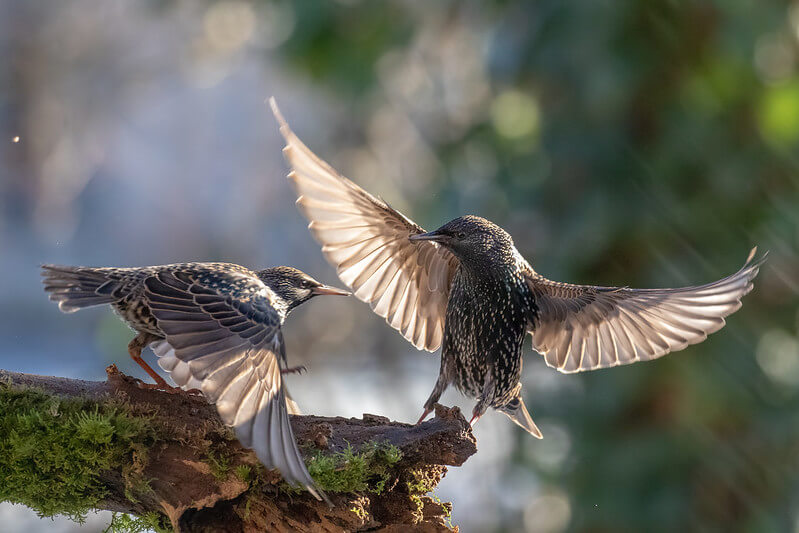 Caught in the garden at 1/2000s, ISO 3200 with the 100–400mm lens on my old Canon 7D Mark II)
Caught in the garden at 1/2000s, ISO 3200 with the 100–400mm lens on my old Canon 7D Mark II)
Tip: Don’t be afraid of lens flare—sometimes it adds character. If you want to reduce it, use a lens hood or shield the sun slightly with your hand.
Mist & Fog: Quiet Drama and Soft Light
Few things create atmosphere like a misty morning or fog-draped field. The light is diffused, soft, and gentle—ideal for capturing peaceful, moody wildlife images.
I often find these are the mornings where the world feels completely still. Just me, the camera, and a quiet shape moving through the haze.
Why Fog Works So Well
- Acts like a natural softbox—no harsh shadows
- Simplifies backgrounds, helping your subject stand out
- Adds mood and mystery to even the most common animals
What To Bring
- Wide-angle lens for landscapes and scale
- Tripod for slower shutter speeds in low light
- Lens cloth to clear condensation (you’ll need it!)
Real Example
A heron gliding silently over the lake at Paxton Pits. There is enough in the soft foggy background to place the bird in its environment.
Tip: Slightly overexpose your shot (+1 stop) to keep the fog light and airy. Cameras often try to darken mist, which flattens the mood.
By understanding and embracing different lighting conditions, you can boost your wildlife photography and add variety to your portfolio.
Whether it’s the warm glow of golden hour, the drama of backlighting, or the mystery of fog and mist, each lighting scenario offers unique creative opportunities.
🌿 Ready to head out into the wild?
Now that you’ve got the gear and a feel for the light, it’s time to plan your first shoot.
In the next guide, I’ll show you how to choose a location, understand animal behaviour, compose your shots, and approach wildlife with care and respect.
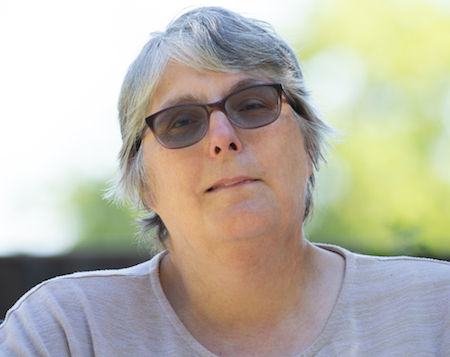
About the Author
Carol is a UK-based wildlife photographer and nature writer with a passion for peaceful walks, patient observation, and capturing life’s quiet wonders.
Through her lens and words, she shares the stories of the natural world — from bluebells and butterflies to birds like the great crested grebe.
Get closer to UK nature
Subscribe to Wild Lens!
Want to discover more hidden walks and wildlife moments?
I’d love to share my latest nature finds, photo tips, and peaceful walk recommendations with you.
💌 Join my newsletter Wild Lens—it’s free, occasional, and always rooted in a love of the natural world.
Subscribe below and come exploring with me.
